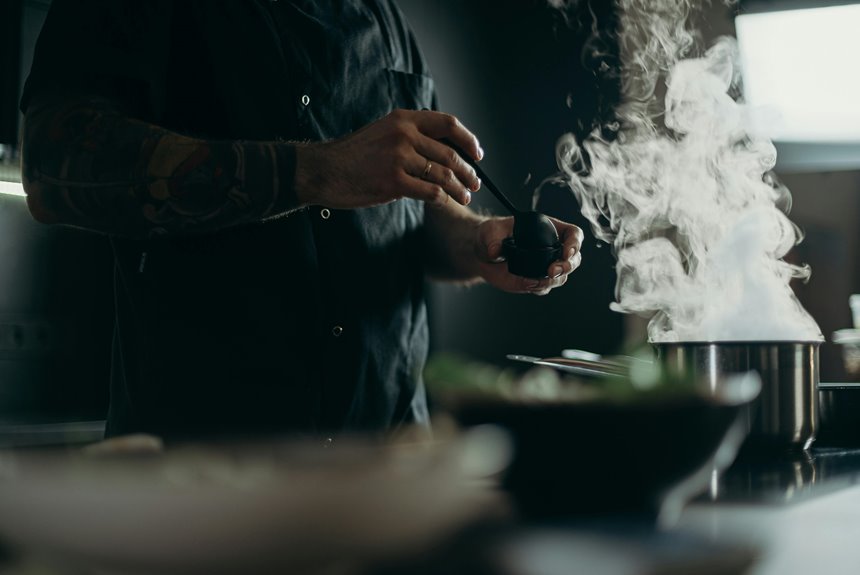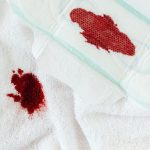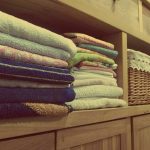When it comes to chef wear, choosing the right fabric is essential for both comfort and professionalism. You want materials that resist stains and allow breathability, ensuring you look sharp even during the busiest shifts. Understanding various fabric types can greatly impact your performance in the kitchen. But what specific qualities should you look for to meet these demands? Let’s explore the important factors that can enhance your culinary experience.
Table of Contents
Key Takeaways
- Cotton fabrics offer excellent breathability and moisture absorption, keeping chefs cool during long shifts.
- Polyester blends provide durability and stain resistance, ensuring uniforms withstand busy kitchen environments.
- Stain-resistant fabrics help maintain a professional appearance and prevent cross-contamination in food preparation areas.
- Lightweight materials with mesh ventilation enhance airflow, improving comfort during high-temperature cooking tasks.
- Eco-friendly options like organic cotton and recycled polyester support sustainability while meeting safety standards in kitchen settings.
Understanding Fabric Types for Chef Wear
When you step into a kitchen, the right fabric can make all the difference in your comfort and performance.
Chef wear typically includes materials like cotton, polyester, and blends. Cotton offers breathability and softness, keeping you cool during long shifts. Polyester, on the other hand, is durable and wrinkle-resistant, making it great for busy environments.
Chef wear is crafted from cotton for breathability and polyester for durability, ensuring comfort and resilience in bustling kitchens.
Blends combine the best of both worlds, providing comfort and easy maintenance. You’ll also find materials like linen, which is lightweight and absorbs moisture well, though it wrinkles easily.
Consider functionality when choosing your fabric; some options are specifically designed for high heat and environments with hot surfaces. Understanding these fabric types will help you make an informed choice for your culinary workwear.
Importance of Stain Resistance in Chef Uniforms
When you’re in the kitchen, the last thing you want is to worry about stains on your uniform.
Stain resistance not only helps maintain a professional appearance but also plays a vital role in meeting hygiene and safety standards.
Keeping your chef wear clean is essential for both your image and the health of your kitchen.
Impact on Professional Appearance
Stain resistance is essential for maintaining a chef’s professional appearance. When you step into the kitchen, your uniform reflects not just your skills, but also your dedication to the craft.
A clean, stain-free uniform conveys competence and professionalism, which can influence customer perceptions.
Imagine the impression you create with:
- Crisp, white chef coats showcasing your culinary finesse
- Dark pants that hide spills and splatters effortlessly
- Stain-resistant fabrics that stand up to the rigors of the kitchen
- A polished look that builds trust with patrons
- Confidence in your appearance, allowing you to focus on cooking
Hygiene and Safety Standards
While a chef’s creativity shines in their dishes, hygiene and safety standards in the kitchen demand uniforms that can withstand spills and contamination. Stain-resistant fabrics not only keep you looking professional but also help maintain a sanitary environment.
When you’re working with food, preventing cross-contamination is essential, and your uniform plays a significant role in that. By choosing materials that repel stains, you reduce the risk of bacteria lingering on your clothing, ensuring a safer workspace.
Additionally, these fabrics allow for easy cleaning, which is important for meeting health regulations. You’ll find that staying clean and presentable not only boosts your confidence but also reflects your commitment to culinary excellence.
Prioritizing stain resistance in your chef wear is an important step towards upholding hygiene standards.
Evaluating Breathability in Chef Fabrics
Breathability in chef fabrics is essential, as it directly impacts comfort and performance in the kitchen.
When you’re working long hours over a hot stove, you need fabrics that let your skin breathe. Here are key factors to evaluate breathability in chef wear:
- Moisture-wicking: Fabrics that draw sweat away from your skin keep you dry and comfortable.
- Lightweight materials: Choose fabrics that won’t weigh you down during busy shifts.
- Natural fibers: Cotton and linen offer excellent breathability and comfort.
- Mesh ventilation: Look for designs with mesh panels to enhance airflow.
- Loose fit: A relaxed fit allows air to circulate, helping you stay cool.
Choosing the right breathable fabric can make a big difference in your kitchen experience.
Durability and Maintenance of Chef Wear
Durability is an essential factor when selecting chef wear, as it directly affects how well your clothing withstands the rigors of a bustling kitchen environment.
You’ll want fabrics that resist tearing and fraying, ensuring they hold up against spills, heat, and frequent washing. Look for materials like polyester blends or heavy cotton, which offer both strength and comfort.
Maintenance is equally important; you should always check care labels for washing instructions to maintain the longevity of your garments.
Avoid using harsh chemicals that can degrade fabric over time. Regularly inspect your chef wear for signs of wear and tear, so you can replace items before they become a liability in the kitchen.
Investing in durable chef wear saves you money and stress in the long run.
Customization Options for Chef Uniforms
Choosing the right fabric for your chef wear isn’t just about durability; it also opens the door to customization options that can enhance your professional image.
You want your uniforms to reflect your style, and there are plenty of ways to achieve that.
Consider these customization options:
- Embroidery: Personalize with your name or restaurant logo for a professional touch.
- Color Variations: Choose colors that align with your brand or culinary theme.
- Unique Patterns: Stand out with distinctive prints or textures.
- Tailored Fits: Opt for custom sizing to guarantee comfort and mobility.
- Accessories: Add aprons, hats, or chef coats that match your individual flair.
These options not only boost your confidence but also create a cohesive look in the kitchen.
Environmental and Safety Considerations in Chef Fabrics
When choosing chef fabrics, you need to evaluate both safety and environmental impact.
Look for materials that meet fire resistance standards to keep you safe in the kitchen, while also exploring eco-friendly options that align with your values.
Balancing these factors can help you make informed choices for your culinary wardrobe.
Fire Resistance Standards
As safety remains a top priority in the kitchen, understanding fire resistance standards for chef fabrics is essential. When you choose the right materials, you protect yourself from potential hazards.
Here are some key features to look for in fire-resistant chef wear:
- Inherent flame resistance: Fabrics that resist ignition inherently, without chemical treatments.
- High-temperature tolerance: Materials that withstand extreme heat without melting.
- Durability: Long-lasting fabrics that maintain their fire-resistant properties after multiple washes.
- Comfort: Breathable materials that keep you cool while being safe.
- Certification: Look for compliance with industry standards, ensuring reliable protection.
Choosing fire-resistant chef fabrics not only enhances your safety but also boosts your confidence while you create culinary masterpieces.
Eco-Friendly Fabric Options
With safety at the forefront, it’s important to contemplate not just fire resistance but also the environmental impact of your chef wear.
Eco-friendly fabrics like organic cotton, recycled polyester, and Tencel offer sustainable options that reduce your carbon footprint. These materials are often produced with fewer chemicals and less water, promoting safer working conditions for you and the planet.
Look for certifications like GOTS or OEKO-TEX, which guarantee that your chef attire meets strict environmental standards. By choosing eco-friendly options, you’re not only protecting the environment but also investing in your health.
Breathability and comfort remain intact, allowing you to work efficiently while making a positive impact.
Frequently Asked Questions
How Do I Choose the Right Fabric for My Specific Kitchen Environment?
To choose the right fabric for your kitchen, consider factors like temperature, moisture levels, and potential stains. Prioritize durability and comfort, ensuring the material suits your cooking style and keeps you looking professional throughout your shift.
Are There Any Certifications for Eco-Friendly Chef Fabrics?
Did you know over 60% of consumers prefer eco-friendly products? When choosing chef fabrics, look for certifications like GOTS or OEKO-TEX, ensuring your materials are sustainable and safe for both you and the environment.
Can Specialized Treatments Affect Fabric Comfort and Feel?
Yes, specialized treatments can greatly affect fabric comfort and feel. They can enhance softness, flexibility, or breathability, but sometimes they might also make the material stiffer or less pleasant against your skin. Choose wisely!
What Are the Best Practices for Washing Chef Uniforms?
Think of washing chef uniforms like a dance; you’ve got to follow the right steps. Use cold water, gentle cycles, and avoid bleach. Air dry to keep them fresh and ready for your next culinary creation.
How Do Humidity Levels Impact Fabric Performance in Kitchens?
Humidity levels can markedly affect fabric performance in kitchens. High humidity makes fabrics heavier, less breathable, and prone to odors, while low humidity can dry out materials. You’ll want to choose fabrics that adapt well to varying conditions.







